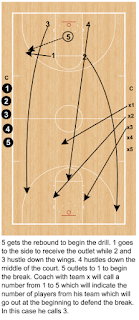Pillar 2: Execution
Pillar 2 of the Pillars of Process is Execution. Execution is broken down into a few categories. First are the fundamentals which are broken down into team and individual. After that the fundamentals can be broken down into the physical and the mental. The next item to be addressed is establishing the identity of your team. The final point of discussion will be the idea of stacking good games and practices together in an effort to improve.
The fundamentals can be broken down into the team and the individual. Execution is very important to take place on both levels but the 2 are taken care of differently. On the team level, the whole idea is to play fast so you want to keep things simple and make sure the first layer is grasped before you proceed to a more difficult layer. If layer is introduced too early, it can cause the team to bog down and start thinking too much. When you think on the court, you tend to slow down which is something you don't want. Introduce all the things your team needs to start the year as quickly as possible. and then have the team go over everything constantly in scrimmages. Once the first game comes around, you gauge your team's progress and add accordingly. The KISS (keep it simple stupid) principle applies here.
In terms of individual fundamentals, we take a different approach. We always find time to work on the fundamentals and we push the players to play pretty hard on individual fundamentals. We stress layups, shooting, dribbling, passing, rebounding, and defense. The emphasis for us is on layups and dribbling and for these we use both 1v0 drills and ssgs to work on them. The rest of the drills are emphasized using ssg but we work on fundamentals everyday and we push our players to improve everyday.
When discussing the physical vs. the mental, players need to execute at both levels. The physical lies with the actual physical execution involved in the game while the mental is more difficult to deal with. The mental involves how to deal with loud crowds. How to deal with end of game situations. How to deal with runs that the other team has against you. Finally it has to deal with staying calm under pressure. These mental obstacles can become easier to deal with when you go over them in practice. Take the time to go over scenarios verbally and in scrimmages. It's difficult to go over all scenarios but if you go over a few they can translate into other issues the team may be confronted with as well. Also, tell your team that you can't control the ebb and flow of games. there will be times where the other team will make a run. What you can control , however, is how you react to these situations. If you react with focus and rise to the challenge you will bounce back. If you panic and keep making the mistakes that got you in the mess in the first place then you will not bounce back.
The physical will be dealt with in practice. To make things easier I always tell my team that the equation involved to gauge if we are executing well is our team total FGAs' vs. The opposition's FGAs'. The way I look at things is that if we create more turnovers than we commit, and out-rebound the opposition, then we will get more shots, which gives us more chances to score, which is the name of the game.
The next thing to discuss is establishing an identity for a team and this point can get tricky. As a coach you need to be flexible in term of the style of play you will teach. A lot of coaches like to say "I coach man only," or "I coach full court pressure only." This is great but unless you get to recruit the type of players you want onto your team, you may not always have the capability of running your style of play given the personnel you have. This is a very important topic which will get a separate blog entry to discuss in more detail.
The last thing we like to talk about with our team is stacking good games and practices on top of each other. The more good practices and games we get under our belt the better off we are. Set up goals for the number of stacked games and practices and when the team hits the number then give them a reward.The next question is what constitutes a good game. Your team can play a game and get blown out by the opposition and the game can still be considered a good game if the team played hard, were not intimidated and tried to execute the game plan. Your team can also win big and the game can be considered a poor game if the team did not play hard or execute. This is where your judgement as a coach will be required. Set up your guidelines and follow them.
In closing, execution is a very important pillar to our process. Emphasize that the team's goal for every game should be getting more shots than the opposition and focus on stacking games and practices.



Comments
Post a Comment